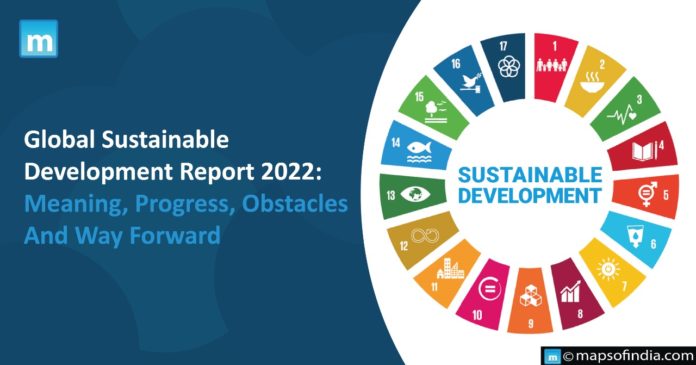Global Sustainable Development Report is a comprehensive evaluation of countries’ achievements toward sustainable development goals. The Sustainable Development Solutions Network (SDSN), an organisation of independent specialists, publishes it.
SDSN was established in 2012 to mobilise worldwide scientific and technology talent to foster real-world problem resolution for sustainable development and the implementation of the SDGs. SDSN is currently dedicated to assisting in executing the SDGs at the national and international levels after its adoption.
Sustainable development Goals are, namely
| SDG | Goal | SDG | Goal |
| 1 | No poverty | 10 | Reduced Inequality |
| 2 | Zero Hunger | 11 | Sustainable cities and communities |
| 3 | Good Health and Well-Being | 12 | Responsible consumption and production |
| 4 | Qulaity Education | 13 | Climate Action |
| 5 | Gender Equality | 14 | Life below water |
| 6 | Clean Water and Sanitation | 15 | Life on Land |
| 7 | Affordable and Clean Energy | 16 | Peace, Justice, and Strong Institutions |
| 8 | Decent work and economic growth | 17 | Partnership for Goals |
| 9 | Industry, Innovation, and Infrastructure |
Basis of Ranking
- Countries are ranked based on their total score
- The overall score assesses the total extent of achievement made toward reaching all 17 Sustainable Development Goals (SDG)
- The score is expressed as a percentage of SDG performance
- A score of 100 implies that all of the SDGs have been met
Performace of countries worldwide:
Top Performers Globally:
| Rank | Country |
| 1 | Finland |
| 2 | Denmark |
| 3 | Sweden |
| 4 | Norway |
- Eastern and Southern Asia nations have accomplished the most on the SDGs following their implementation in 2015.
- Bangladesh and Cambodia are the top performers.
- However, globally, Venezuela is the worst performer.
Key pointers of the report
Concerning the World
- Multiple and concurrent health, environmental, ecological, geopolitical, and armed crises are significant setbacks for global sustainable development.
- This is the second consecutive year that the world average of the SDG Index has decreased, primarily due to the effects of the pandemic on SDG1 and SDG8, as well as low progress on SDG11-15.
- Military actions, particularly the war in Ukraine, have significant worldwide spillover effects on food availability and energy rates, exacerbated by climatic and environmental problems.
Concerning India
- India was placed 121st out of 163 nations. In 2020, it was rated 117, and in 2021, it was placed at 120.
India’s readiness has deteriorated
- Compared to other nations, India’s preparation for the UN Sustainable Development Goals (SDGs) has deteriorated over time, and it is not well prepared to achieve all of them.
Major Obstacles
- The country continued to confront significant challenges in reaching 11 of the 17 SDGs, lowering its global position in SDG preparation.
- Securing respectable employment (SDG 8) has grown more complex.
- The research claims that India is on pace to meet SDG 13 on climate action.
- On the other hand, the State of India’s Environment, 2022 warned that the nation was experiencing severe issues in this sector.
- From 2019 to 2020, India’s effectiveness on climate action – SDG 13 — has decreased.
- This drop in India’s overall performance is mainly owing to 8 states — Uttar Pradesh, Rajasthan, Bihar, Karnataka, Andhra Pradesh, Telangana, Punjab, and Jharkhand — whose SDG 13 ratings have fallen in the last two years.
Progress
- Around ten of these targets have significantly progressed to those achieved in 2021.
Way Forward
Scale-up new partnerships and innovations
- Scale-up new collaborations and breakthroughs that arose during the Covid-19 epidemic, notably in professional cooperation and data, to serve the SDGs.
Technological and Scientific Innovations
- Research, technological developments, and data centres may aid in the identification of solutions during times of crisis and can make critical contributions to addressing today’s significant concerns.
- These require expanded and sustained expenditures in statistical capacity, R&D, training, and skill development.




